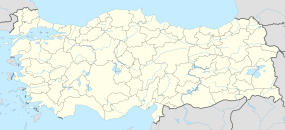Side
| Σίδη | |

The Temple of Apollo is located at the end of Side's peninsula.
|
|
| Location | Antalya Province, Turkey |
|---|---|
| Region | Pamphylia |
| Coordinates | 36°46′00″N 31°23′20″E / 36.76667°N 31.38889°ECoordinates: 36°46′00″N 31°23′20″E / 36.76667°N 31.38889°E |
| Type | Settlement |
| History | |
| Founded | 7th century BCE |
| Cultures | Greek, Roman, Byzantine |
| Site notes | |
| Condition | In ruin |
Side (Greek: Σίδη) is an ancient Greek city on the southern Mediterranean coast of Turkey, a resort town and one of the best-known classical sites in the country. It lies near Manavgat and the village of Selimiye, 78 km from Antalya in the province of Antalya.
It is located on the eastern part of the Pamphylian coast, which lies about 20 km east of the mouth of the Eurymedon River. Today, as in antiquity, the ancient city is situated on a small north-south peninsula about 1 km long and 400 m across.
Strabo and Arrian both record that Side was founded by Greek settlers from Cyme in Aeolis, a region of western Anatolia. This most likely occurred in the 7th century BC. Its tutelary deity was Athena, whose head adorned its coinage.
Dating from the tenth century B.C., its coinage bore the head of Athena (Minerva), the patroness of the city, with a legend. Its people, a piratical horde, quickly forgot their own language to adopt that of the aborigines.
Possessing a good harbour for small-craft boats, Side's natural geography made it one of the most important places in Pamphylia and one of the most important trade centres in the region. According to Arrian, when settlers from Cyme came to Side, they could not understand the dialect. After a short while, the influence of this indigenous tongue was so great that the newcomers forgot their native Greek and started using the language of Side. Excavations have revealed several inscriptions written in this language. The inscriptions, dating from the 3rd and 2nd centuries BC, remain undeciphered, but testify that the local language was still in use several centuries after colonisation. Another object found in the excavations at Side, a basalt column base from the 7th century BC and attributable to the Neo-Hittites, provides further evidence of the site's early history. The name Side may be Anatolian in origin, meaning pomegranate.
...
Wikipedia

